The Rhythm of Life On Bonaire
This small Caribbean island walks the conservation walk
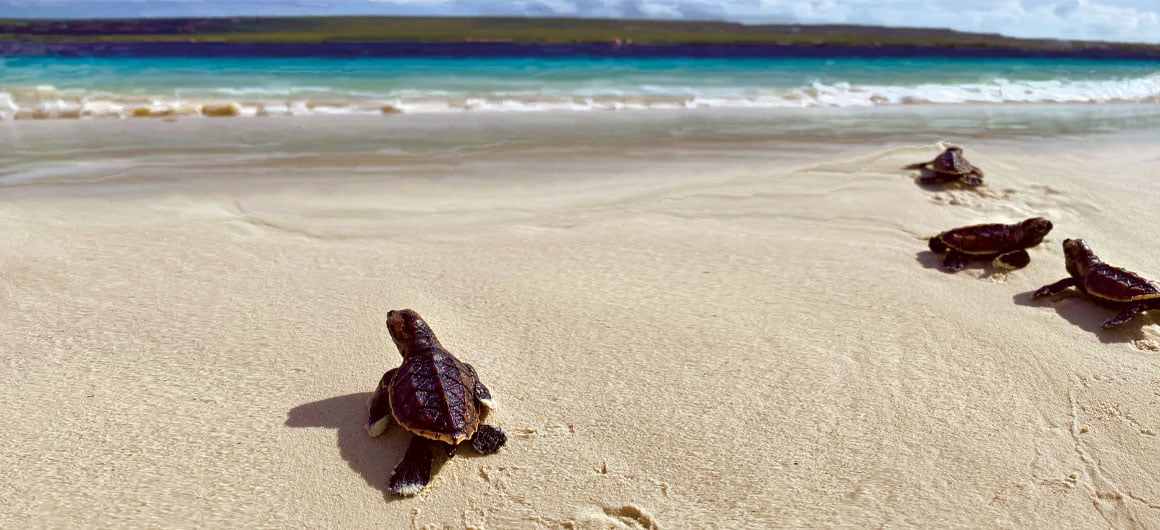
”I hope we get to see baby turtles,” whispered the woman beside me on the small ferry as we headed toward an uninhabited islet.
I smiled and nodded. Wouldn’t that be magical?
That morning, I’d signed up to accompany Sea Turtle Conservation Bonaire (STCB) on one of its thrice-weekly nest-monitoring excursions, offered May through November. For a $40 donation, visitors tag along with the field team and trained volunteers as they scout for evidence of newly created nests and newly hatched turtles on Klein (little) Bonaire, an islet off the main island. Three kinds of endangered sea turtles—green, hawksbill and loggerhead—lay eggs on Bonaire’s two islands, and STCB monitors and protects them all.
This jaunt would cap my five days of immersing myself in the abundant natural riches and easygoing island vibes of Bonaire—the B island in the ABC Islands of the lower Caribbean, which also includes Aruba and Curaçao.
Bonaire’s reputation as a conservation standout drew me here for my first visit. A solo traveler and nature geek, I was eager to join the many expert-guided tours.
Since the late 1960s, this island of 25,000 inhabitants, still under Dutch administration, has sought to protect its fragile natural resources from development and potentially harmful activities. The island’s 6,700-acre marine park—which includes reefs, beaches and mangroves—was one of the world’s first, and Bonaire calls itself a “blue destination,” its own impressive spin on striving “for the perfect synergy between nature, culture and economy.” Abundant sea turtles, healthy bird populations and gorgeous corals lure explorers like me, who contribute to conservation efforts by paying for a $40 nature tag to participate in water activities and to enter the marine park or the 14,000-acre Washington Slagbaai National Park.
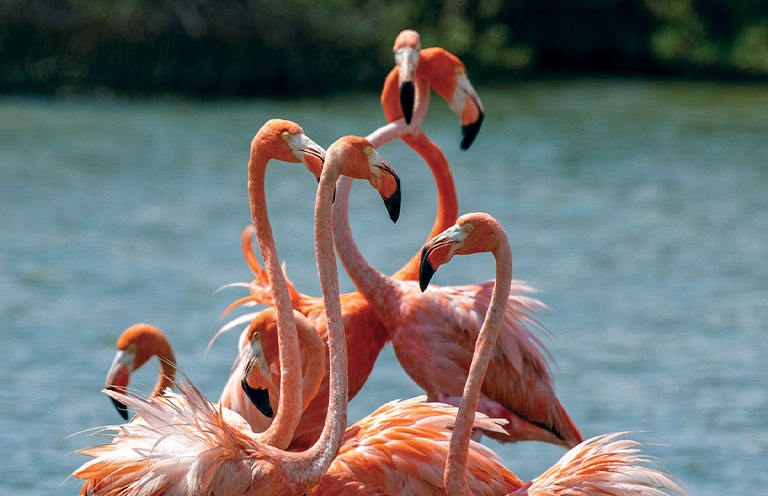
National park and in-town gems
On my first day in Bonaire, I had joined four other visitors and our guide, Rolando, and headed north to the land-based national park. Along the way, we passed through the colorful capital and main port town of Kralendijk. Brightly painted Dutch colonial buildings housing shops and restaurants created a festive mood, and I planned to circle back later, especially for some waterfront dining to savor the freshest of seafood.
Much of Bonaire, including the park, is a tropical dry forest, so any bright splashes of wildlife amid the many varieties of cacti that stud the land caught my eye. Located on the migration flyway from South America, Bonaire boasts more than 200 types of birds. Flamingos make a colorful addition, and the island hosts a sanctuary with up to 10,000 of them.
As we passed Gotomeer, a saltwater lagoon just outside the park, Rolando slowed the van. To catch insects, flamingos swing their sloping necks from side to side. They were a hoot to watch. Later, inside the park, a yellow and green flash crossed my vision—a parakeet. Soon I spied another bright bird atop a cactus, feeding on its fruit.
Along the park’s coastal loop, we stopped at several rocky sites that bordered small but gorgeous sandy beaches and the popular 1,000 Steps dive site. Actually, there are only 67 steps from the road to the beach, but it apparently feels much longer for divers carrying heavy gear.

My snorkel gear was light, so I masked up and submerged. Rainbow-hued parrotfish abound in these high-visibility waters. I also spotted a school of blue tang that I trailed as they flowed around coral formations. Like most of the Caribbean, some of Bonaire’s coral has been hit by disease, exacerbated by the challenges of rising sea temperatures. Still, lots of healthy corals, butterfly fish and sea fans caught my appreciative eye.
Over the next few days, I circled back to Kralendijk after my daytime adventures. The restaurant La Balandra juts out into the water in imitation of a Spanish ship and is a fun and breezy spot for lunch or dinner. During my cruise aboard La Melisa, a wooden sailboat, I relished a six-course gourmet meal while enjoying the sunset. The island manages to be busy without feeling crowded, perhaps because visitors can spread themselves out among its many offerings.
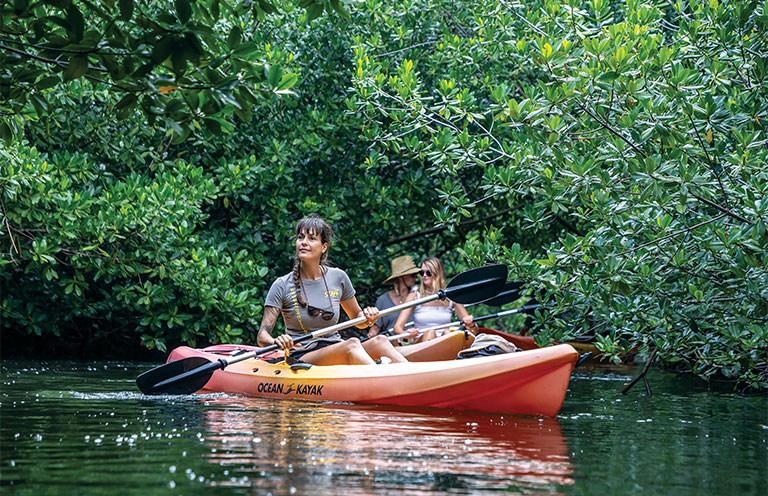
Atop and immersed in Lac Bay
One day, I made for the island’s southeast side to snorkel and kayak through mangroves in the protected Lac Bay. Since I was the only non-Dutch speaker in the group of 16, my guide, Eric, gave me a pre-trip overview of how essential mangroves are. They protect the shoreline during storms, provide a safe nursery
habitat for fish and store more carbon dioxide than rainforests.

After paddling across the windy bay and its abundant seagrass beds (aka sea turtle food), we kayakers tethered our boats amid the mangroves, donned snorkel gear and swam into a six-foot-wide channel. Schools of small fish hid in the tangle of roots. Shafts of sunlight pierced the dense leaves, occasionally spotlighting the array of orange, purple, pink and blue sponges thriving there. In this shadowy, quiet realm, I felt like I was floating through a submerged and sacred cathedral with illuminated stained glass.
After a seafood lunch at a beach bar, I was ready to get back to my current digs, Delfins Beach Resort, and sidle up to the pool bar for some serious relaxation. My evenings of sunset dining beachside—both at Delfins and the beach club Ocean Oasis Bonaire—were an ideal counterbalance to my active days.
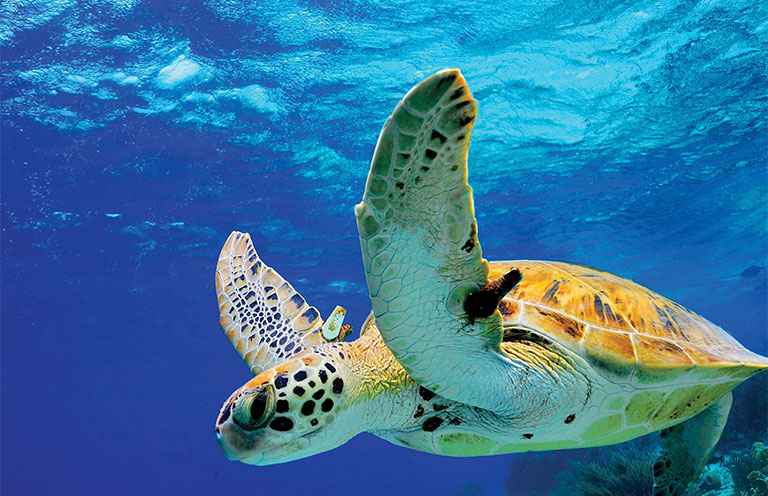
Sea turtle magic
Too soon, it was my last morning. After our 20-minute boat ride to Klein Bonaire, two STCB guides, several volunteers and three of us observers waded ashore from where the boat landed in the shallows. The first boat to arrive, we had the stunningly beautiful No Name Beach to ourselves. I followed Daan and Kate, our field leads, as their gazes swept the sand and found flipper marks made by a mama turtle, which look like tire tracks in the sand running from the waterline toward the higher vegetation. The team examined them to determine if she was merely scoping the site or had actually laid eggs. These tracks were just a crawl, they concluded.
Following the GPS coordinates to a nest the team had found 60 days earlier, Daan spotted a sand depression, a sign of a hatched nest. Baby sea turtles try to leave in the dark en masse to help prevent predation, but some may get stuck behind, as was the case this time.
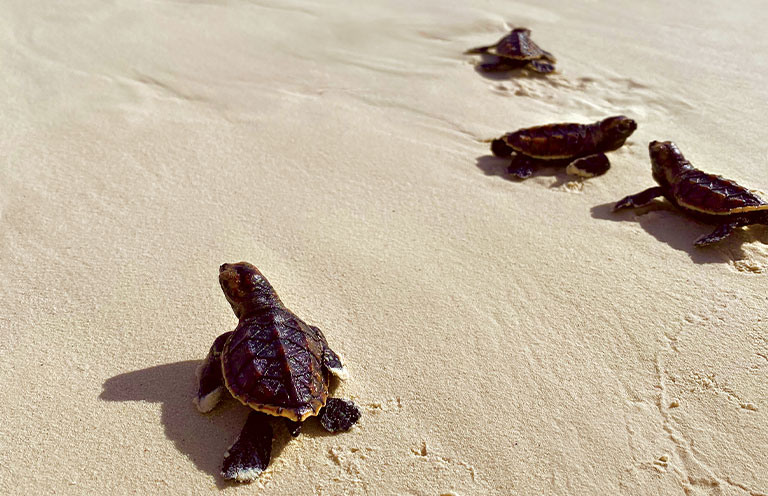
When the first live baby turtle from the nest wriggled in Daan’s palm, I exclaimed joyfully. He placed it in a bucket of sand, and eight siblings soon followed. Some looked bedraggled, but when released close to the water, all were strong enough to waddle into the sea. In 2024, sea turtles made 131 nests like these on Bonaire and Klein Bonaire, resulting in 10,377 healthy hatchlings.
My eyes teared as the hatchlings swam away. I wished them fair journeys and hoped at least one will return in 25 years to build her nest here. Bonaire will keep its beaches ready and awaiting.
. . . . .
Want to tag along with STCB? Contact cepa@bonaireturtles.org. Other excursions can be booked through your AAA Travel Advisor, who can also book your lodging.
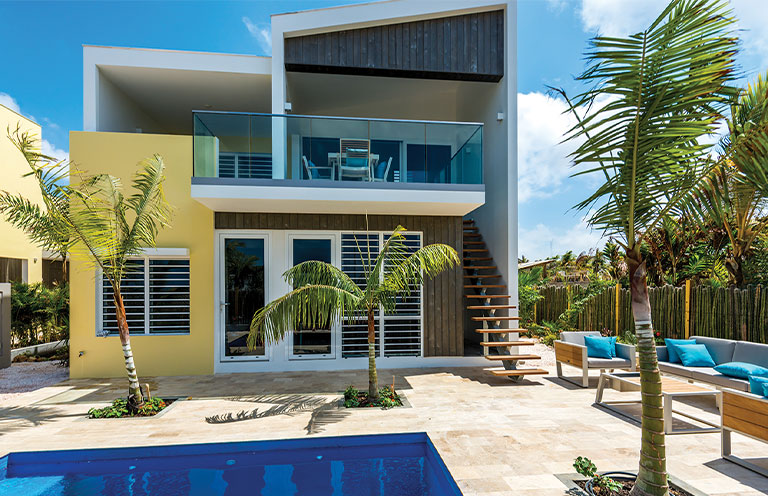
Where to stay
Two options to consider: Lodge in luxury with an apartment or villa at Delfins Beach Resort, which features a pool bar and coastal swimming, or a stay at Divi Flamingo Beach Resort & Casino, which offers shore and boat diving. Both lodgings have private beaches, spas and on-site dining.
